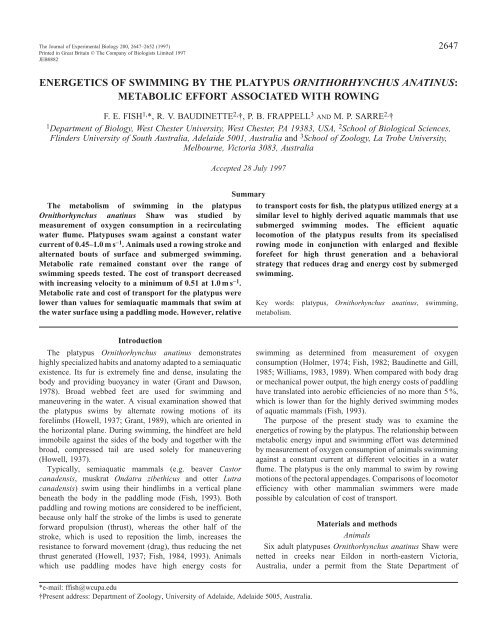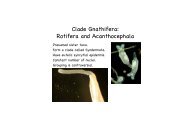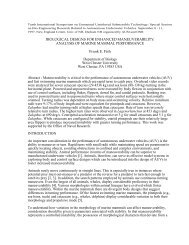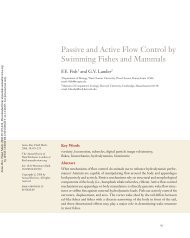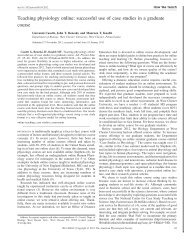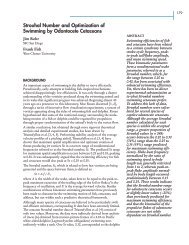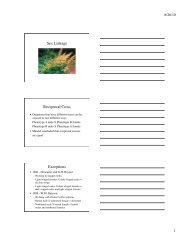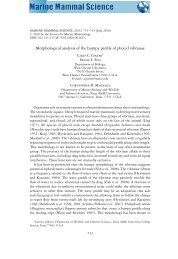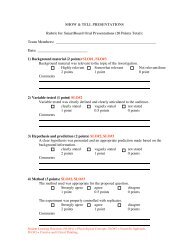energetics of swimming by the platypus ornithorhynchus anatinus
energetics of swimming by the platypus ornithorhynchus anatinus
energetics of swimming by the platypus ornithorhynchus anatinus
You also want an ePaper? Increase the reach of your titles
YUMPU automatically turns print PDFs into web optimized ePapers that Google loves.
2650F. E. FISH AND OTHERSThe <strong>platypus</strong> has an active metabolic rate that is lowcompared with that <strong>of</strong> o<strong>the</strong>r paddle-propulsing semiaquaticmammals <strong>of</strong> similar body size. Swimming muskrats (Ondatrazibethicus) have an active metabolic rate 2–5.1 times that <strong>of</strong><strong>the</strong> <strong>platypus</strong> (Fish, 1982), whereas <strong>swimming</strong> mink (Mustelavison) expend energy at a rate 4.1–10.7 times greater(Williams, 1983). The <strong>platypus</strong> also maintains a low restingmetabolic rate compared with aquatic eu<strong>the</strong>rian mammals.Grant and Dawson (1978) determined that <strong>the</strong> restingmetabolism <strong>of</strong> <strong>the</strong> <strong>platypus</strong> in air was 35 % lower than that <strong>of</strong>eu<strong>the</strong>rian mammals and was 37–54 % lower in water.The reduced metabolic effort required during <strong>swimming</strong> <strong>by</strong><strong>the</strong> <strong>platypus</strong> is reflected in its COT (Fig. 4). The <strong>platypus</strong> hasa COT 2.4 times greater than <strong>the</strong> minimum COT for a fish <strong>of</strong>equivalent body mass (Brett, 1964). This is much lower than<strong>the</strong> equivalent factor for o<strong>the</strong>r semiaquatic and terrestrialmammals (Fig. 4), which have a COT 8.9–24.2 times greaterthan that <strong>of</strong> fish. However, <strong>the</strong> relative COT for <strong>the</strong> <strong>platypus</strong>is within <strong>the</strong> range <strong>of</strong> 1.9–5.6 times greater than fish COTfound for highly derived aquatic mammals, including seals, sealions and whales. These differences may reflect <strong>the</strong> energyusage dictated <strong>by</strong> different <strong>swimming</strong> modes.The <strong>platypus</strong> swims <strong>by</strong> pectoral rowing (Howell, 1937;Grant, 1989). Although some semiaquatic mammals (e.g. polarbear Ursus maritimus and ferret Mustela putorius) swimexclusively using <strong>the</strong>ir pectoral appendages, <strong>the</strong>ir strokes areconfined to <strong>the</strong> parasagittal plane similar to <strong>the</strong> quadrupedaland pectoral paddling used <strong>by</strong> o<strong>the</strong>r semiaquatic mammals(Flyger and Townsend, 1968; Fish, 1993). An examination <strong>of</strong>paddling has shown <strong>the</strong>se modes to be inherently inefficient(Fish, 1992). Energy is lost mainly due to inertial effects, nonthrust-generatingmovements during <strong>the</strong> power stroke andincreased drag while repositioning <strong>the</strong> appendage during <strong>the</strong>recovery stroke. These losses translate into aerobic efficiencies(<strong>the</strong> energy needed to provide thrust divided <strong>by</strong> <strong>the</strong> totalmetabolic input) <strong>of</strong> no greater than 5 % and mechanicalefficiencies (<strong>the</strong> energy needed to generate thrust divided <strong>by</strong><strong>the</strong> total mechanical work) <strong>of</strong> only 33 % (Fish, 1992).The highly aquatic sea lion Zalophus californianus swimswith <strong>the</strong> foreflippers using a combination <strong>of</strong> lift-basedoscillations and rowing motions (Feldkamp, 1987b). Theselatter motions produce <strong>the</strong> greater part <strong>of</strong> <strong>the</strong> thrust generatedover <strong>the</strong> stroke cycle. This <strong>swimming</strong> mode results in aerobicefficiencies <strong>of</strong> 12–30 % and a maximum mechanical efficiency<strong>of</strong> 80 % (Feldkamp, 1987a; Williams et al. 1991). Fish (1996)argued that <strong>the</strong> <strong>platypus</strong> represents a possible modern analogto an intermediate <strong>swimming</strong> mode between drag-basedpaddlers and lift-based pectoral oscillators. Indeed, <strong>the</strong> patternfor <strong>the</strong> <strong>platypus</strong> is more similar to that <strong>of</strong> <strong>the</strong> sea lion than that<strong>of</strong> semiaquatic paddlers. For <strong>the</strong> <strong>platypus</strong> and sea lion, strokefrequency increases linearly with increasing U (Feldkamp,1987b), whereas frequency is independent <strong>of</strong> U in paddlers(Williams, 1983; Fish, 1984). Although a detailed analysis <strong>of</strong><strong>the</strong> <strong>swimming</strong> dynamics <strong>of</strong> <strong>the</strong> <strong>platypus</strong> has not beenundertaken, <strong>the</strong> rowing stroke may have a reduced metaboliccost due to efficiencies higher than for semiaquatic paddlers.The ability to increase <strong>swimming</strong> efficiency <strong>by</strong> enhancingthrust generation is associated with <strong>the</strong> morphology <strong>of</strong> <strong>the</strong>propulsive forefeet in <strong>the</strong> <strong>platypus</strong>. Webbing on <strong>the</strong> forefeet isbroad and extends beyond <strong>the</strong> digits during <strong>swimming</strong> (Grant,1989). When fully spread (abducted), <strong>the</strong> forefeet <strong>of</strong> <strong>the</strong><strong>platypus</strong> have a triangular planform which is <strong>the</strong> optimal shapefor maximizing thrust production during paddling (Blake,1981). The forefeet constitute <strong>the</strong> largest surface area <strong>of</strong> any<strong>of</strong> <strong>the</strong> extremities <strong>of</strong> <strong>the</strong> <strong>platypus</strong>, and <strong>the</strong> combined surfacearea <strong>of</strong> <strong>the</strong> forefeet is 13.6 % <strong>of</strong> total body surface area (Grantand Dawson, 1978). This is comparable with that <strong>of</strong> sea lionforeflippers, which represent 15.7–16.6 % <strong>of</strong> total body surfacearea (Feldkamp, 1987a), but is larger than <strong>the</strong> propulsivehindfeet <strong>of</strong> semiaquatic rodents, which represent 4.0–6.4 % <strong>of</strong><strong>the</strong> wetted surface areas <strong>of</strong> <strong>the</strong> body (Mordvinov, 1976).Because a large mass <strong>of</strong> water can be accelerated <strong>by</strong> <strong>the</strong> foot,efficiency will be greater for <strong>the</strong> <strong>platypus</strong> than for paddlerswith relatively smaller foot areas (Alexander, 1983).Semiaquatic paddling mammals swim at <strong>the</strong> surface, but<strong>platypus</strong>es dive frequently, which can reduce metabolic cost(Fish, 1992; Evans et al. 1994). Pronounced bradycardia and<strong>the</strong> associated hypometabolism during submerged <strong>swimming</strong>Fig. 4. Dimensionless cost <strong>of</strong> transport(COT) versus body mass. Filledsymbols represent COT values forpaddling semiaquatic mammals whensurface <strong>swimming</strong>, and open symbolsrepresent submerged <strong>swimming</strong> <strong>by</strong>aquatic mammals. Data from Holmer(1974); Costello and Whittow (1975);Kruse (1975); Øritsland and Ronald(1975); P. E. DiPrampero, personalcommunication; Fish (1982); Williams(1983, 1989); Innes (1984); Davis et al.(1985); Worthy et al. (1987); Feldkamp(1987a) and Williams et al. (1992). Thesolid line represents <strong>the</strong> extrapolatedminimum COT for salmonid fish, fromdata <strong>by</strong> Brett (1964).Cost <strong>of</strong> transport1010.10.010.1110Mass (kg)1001000HumanMinkMuskratPlatypusSealSea lionSea otter (surface)Sea otter (submerged)WhaleFish
2652 F. E. FISH AND OTHERSfunction in <strong>the</strong> <strong>platypus</strong>. In Platypus and Echidnas (ed. M. L. Augee),pp. 127–133. Sydney: Royal Zoological Society <strong>of</strong> New South Wales.MORDVINOV, YU. E. (1976). Locomotion in water and <strong>the</strong> indices <strong>of</strong>effectiveness <strong>of</strong> propelling systems for some aquatic mammals.Zool. Zh. 55, 1375–1382.ØRITSLAND, N. A. AND RONALD, K. (1975). Energetics <strong>of</strong> <strong>the</strong> freediving harp seal (Pagophilus groenlandicus). Rapp. P.-V. Reun.Cons. int. explor. Mer. 169, 451–454.SCHMIDT-NIELSEN, K. (1972). Locomotion: Energy cost <strong>of</strong> <strong>swimming</strong>,flying and running. Science 177, 222–228.TUCKER, V. A. (1970). Energetic cost <strong>of</strong> locomotion in animals.Comp. Biochem. Physiol. 34, 841–846.VIDELER, J. J. AND NOLET, B. A. (1990). Cost <strong>of</strong> <strong>swimming</strong> measuredat optimum speed: Scale effects, differences between <strong>swimming</strong>styles, taxonomic groups and submerged and surface <strong>swimming</strong>.Comp. Biochem. Physiol. 97A, 91–99.WEBB, P. W. (1975). Hydrodynamics and <strong>energetics</strong> <strong>of</strong> fishpropulsion. Bull. Fish. Res. Bd Can. 190, 1–158.WILLIAMS, T. M. (1983). Locomotion in <strong>the</strong> North American mink, asemi-aquatic mammal. I. Swimming <strong>energetics</strong> and body drag. J.exp. Biol. 103, 155–168.WILLIAMS, T. M. (1989). Swimming <strong>by</strong> sea otters: adaptations for lowenergetic cost locomotion. J. comp. Physiol. A 164, 815–824.WILLIAMS, T. M., FRIEDL, W. A., FONG, M. L., YAMADA, R. M.,SEDIVY, P. AND HAUN, J. E. (1992). Travel at low energetic cost <strong>by</strong><strong>swimming</strong> and wave-riding bottlenose dolphins. Nature 355,821–823.WILLIAMS, T. M., KOOYMAN, G. L. AND CROLL, D. A. (1991). Theeffect <strong>of</strong> submergence on heart rate and oxygen consumption <strong>of</strong><strong>swimming</strong> seals and sea lions. J. comp. Physiol. B 160, 637–644.WITHERS, P. C. (1977). Measurement <strong>of</strong> V O∑ and V CO∑ andevaporative water loss with a flow-through mask. J. appl. Physiol.42, 120–123.WORTHY, G. A. J., INNES, S., BRAUNE, B. M. AND STEWART, R. E. A.(1987). Rapid acclimation <strong>of</strong> cetaceans to an open-systemrespirometer. In Approaches to Marine Mammal Energetics (ed. A.C. Huntley, D. P. Costa, G. A. J. Worthy and M. A. Castellini), pp.115–126. Sp. Pub. Soc. Mar. Mamm. No.1.


